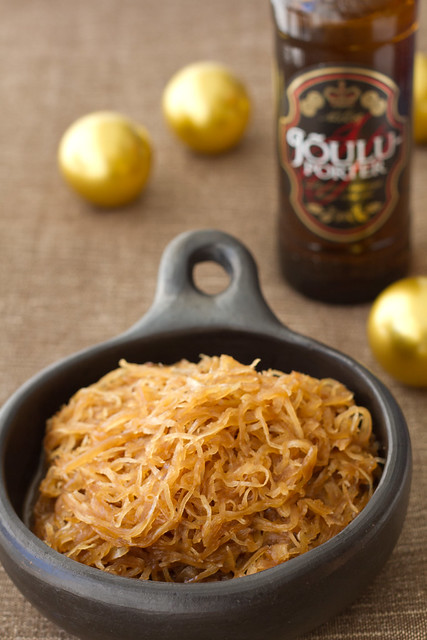 Photo by Juta Kübarsepp for the November 2013 issue of Kodu ja Aed magazine.
Photo by Juta Kübarsepp for the November 2013 issue of Kodu ja Aed magazine.
Last Sunday K. and I headed to a small village called
Pedaspea in the beautiful nature reserve
Lahemaa in Northern Estonia, to spend a day with his friends cooking, eating, walking, playing
Scrabble and generally catching up. We were supposed to bring along the main course, and thus we spent hours last week trying to decide what to make. Eventually we packed along our trusty old 5-quart cast-iron cooking pot (Dutch oven?), my sharp cook's knife, and picked up some nice beef from our local butcher and some potatoes, a bottle of beer and a pot of thyme from the grocery store.

After an hour's drive we arrived in the beautiful location on the seaside, regretting that the weather wasn't good enough for a quick swim, as the house is about 20 metres from the sea:) We then unpacked our groceries, sliced and fried and layered and seasoned the meat and veg, carefully placed our cast iron pot into the oven full of hot coals, and ventured out for an hour to explore the surroundings.
When back, the hosts Ellen and Jaan served us two dishes from Tessa Kiros' beautiful book on Italian food,
Twelve: A Tuscan Cookbook. For starters, we had grilled bread with stewed Savoy cabbage (
Crostone di Cavolo). And for dessert we enjoyed her
Almond Cantucci together with
Zabaglione that I had the pleasure of whipping up quickly. And in between those two beautiful dishes we savoured our main course, a
Beef and Beer Oven Stew. The recipe I used (actually recipes, as I used three slightly different ones to come up with my own version) is Finnish, and the dish is called
Merimiespata or
Sailor's Stew. It was my first time to make it, but definitely not the last. There are very few ingredients - beef, potatoes, onions, beer. After initial preparation you can just leave it to slowly cook away in the oven for about 2 hours. And as it already contains both the meat and the potatoes, then it's a meal on its own - no need for a side salad or such like, although crusty bread wouldn't be out of place. And I liked the slightly sharp flavour of the dish given by beer. We used a light Estonian beer (A Le Coq premium, 4.7%), but I imagine many other types of beer would be good, too.
Merimiespata aka Finnish Beef and Beer Stew
(
Meremehepraad)
Adapted from various sources
Serves 6

600 g lean beef (sirloin is good)
1 Tbsp oil
1 Tbsp butter
1.5 tsp salt
1 tsp freshly ground black pepper
2 large onions
1 tsp sugar
1 kg potatoes, peeled and sliced
a 0.5 litre bottle beer (I used A Le Coq)
300 ml beef stock
a bay leaf or two
fresh thyme, to garnish
Lay half of the potatoes into the iron-cast cooking pot, season lightly with salt.
Cut the beef cross-wise into 1.5 cm slices. Heat oil and butter on a heavy frying pan on a high heat, brown the meat slices on both sides (about 3-5 minutes). Season with salt and pepper and place on top of the potatoes.
Peel and halve the onions, slice thinly. Fry gently on the frying pan for about 5 minutes, then add sugar and fry for another 4-5 minutes, until onions are translucent and softened. Take care not to burn them! Scatter on top of the beef slices, together with any pan juices.
Cover with the rest of the potato slices.
Now pour over the beer, then add enough beef stock to just cover the potatoes.
Tuck a bay leaf into the pot, cover tightly and place either into a 175 C preheated oven for about 2 hours, or into a oven full of hot coals.

When finished, test for doneness with a sharp knife (like I'm doing on the photo here). Remove from the oven, garnish with some thyme and serve.
Can be re-heated on the next day or even on the following day.














































